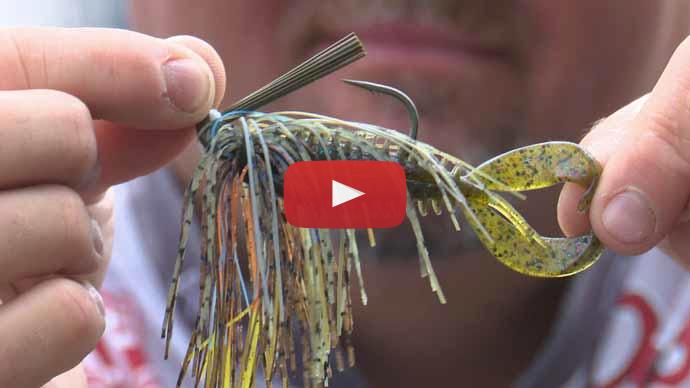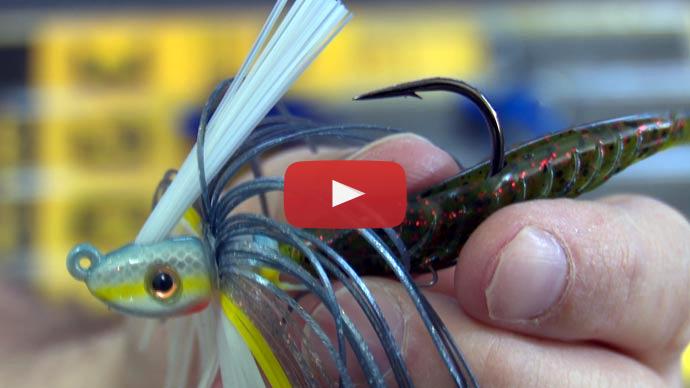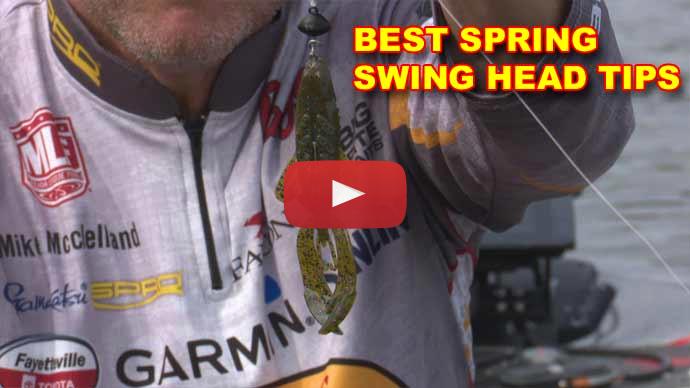Hey, everyone, Mike McClelland, professional angler. We are here with BassResource and we're here to talk spring jig fishing. One thing about it, if you look back through, I mean, if I look back through my career or anybody that's followed me, you're going to know that a jig has played a major role in not only a few of my tournament wins, but just the successes I've had along the way. And you know, one thing about it, a jig is something that... I'm going to say 99% of the tournaments I fish throughout the course of a year, I'm going to have some rods rigged with jigs in my boat, no matter what season it is.
And like I said, we're here talking spring jig fishing. And the thing about it, when I start talking about spring, I'm referring to that period when the fish start getting into that pre-spawn mode. They start staging, they start moving up, they start feeding up a little bit prior to actually going up and spawning. And there's a lot of different jigs on the market today.
And I'm one of those, I still use a lot of jigs that the company, Bass X makes. My son hand-ties some jigs for me. I purchase a lot of various brands of jigs because I want to have an assortment of a lot of different things. But one thing about it, the jigs that I use day in day out, you've got to have a good flipping jig, you've got to have a good football jig, you've got to have a good just roundhead ball style jig, and then you've got to have a good swimming jig.
And you know, when you look at the springtime of the year, all the lakes across the country vary, but there's very few lakes in the spring that I would really feel like I don't have a really, really good shot of catching some fish on a jig.
And when it comes to jig fishing, I mean, typically the sizing in the spring is probably going to be anywhere from a 3/8 up to about a 5/8 for my personal uses and the way I'm going to fish a jig. A football jig, you can see right here, I've got a 3/8 ounce and a 1/2 ounce football jig rigged up. And these two jigs are jigs that I'm going to utilize to do a lot of things with.
And a lot of people, you know, they look at a football jig or they talk about football jig fishing and they always just think structure. You know, getting offshore, fishing things like that. But to me, a football jig is a super, super versatile jig. It is a jig that you can fish around boat docks, you can fish around the outside edge of grass, you can fish in rock, you can fish on gravel. There's just so many different places that you can throw a football jig and I'm always going to have one tied on.
The weight of the jig to me is so important due to two or three different things. Rate of fall is one, you know when the water temperature is really cold, the rate of fall becomes a big deal and you have to play with the weights of your jigs whether you're throwing 3/8, a 1/2, a 5/8 to get that correct rate of fall.
The trailers become pretty important too when it comes to, you know, how that jig's going to fall and how you want it to fall. A lot of times in the spring, I'm typically, you know, if I'm fishing cleaner clear water, I tend to throw a little bit more finesse-y stuff. I mean, you can see right here I've got a Big Bite Baits Twin Tail Grub on. It's, you know, a bait that if you're trying to generate bites, a little football jig with Twin Tail Grub is a bait that will get a lot of bites.
When it comes to the line, and the rod, and the reel that I'm going to use, fishing in the spring, you're typically dealing with cooler temperatures. And, you know, a lot of people are just like, "I'm going to throw fluorocarbon on my jig all the time." Well, I totally agree with that, but the types of fluorocarbon that you throw become really, really critical.
When I'm fishing a jig in colder weather I like a Sunline Sniper. It's a little bit softer. It's a little bit more pliable. It's got a little bit more stretch. It just works better in colder temperatures. So Sunline, anywhere from typically, and my ranges are going to go really dramatic. Very seldomly do I throw a jig on less than a say 12-pound Sniper in the spring. I may throw it on everything up to, you know, 20 or 22-pound Sniper depending on what size of jig and what type of cover I'm fishing.
Trailers again are really, really important. You know, a lot of times I throw, like, this College Craw-style trailer. I'll throw a Big Bite Fighting Frog a lot for a trailer. I really mix my trailers up a lot, you know, trying to find that action that a fish wants. Chunk-style trailers really really become critical sometimes in the spring. Fish don't necessarily want a ton of action on a bait early in the spring, you know, everything in the system, the water's cold, the bait fish aren't moving around fast, crawfish are just coming out of hibernation. Nothing's really moving that fast, so a lot of different things got to come in mind when you start thinking about what jigs you want to throw in the spring.
Another thing is really critical is color. To me, you know, in the spring fish are generally focusing on crawfish. Probably some brim get mixed into the equation. So you want to make sure, you know, you got jigs colored in those manners.
And man, I still pay so much attention to when I'm catch the first fish or two, if he's got a crawfish pinch or sticking out of his mouth or something I really pay attention to what colors I'm seeing. You know, so often early in the spring sometimes the crawfish will have a lot of bright, you know, red in them, orange. Occasionally, you'll have some that got some blues and purples So, you know, those are the things that you really want to keep in mind when you're trying to match the hatch, in my opinion.
Another jig that I utilize a ton day in day out is a little ball head jig. Typically always a 1/2 ounce in the spring, hand-tied brown round or brown round with a little bit of white mixed into it. The reason I like the white is just a little added flash. You know, I'm trying to mimic a crawfish. I'm trying to mimic whatever the bass are feeding on but that little few strands of white sometimes I feel like gives that jig a little bit of flash. And, you know, the bottom of most crawfish are pearl or kind of white-colored. A shad, you know, could be flipping in there and it just gives that little added flash. And that's a bait that I generate a lot of bites on, especially around boat docks, you know, isolated cover. I don't necessarily, you know, fish a jig like that in bushes and things like that, but more isolated-type cover.
And then you've always got to have a swim jig on hand. You know, typically the fish start getting a little bit aggressive as that water temperature warms up, especially if you're fishing lakes with vegetation, bushes, laydown logs, things of that nature.
Generally, I'm going to throw a swim jig in anywhere from a 1/4 up to occasionally a 1/2 ounce in the spring depending on, you know, the water depth that I'm trying to fish it in, whether I'm fishing it over the top of grass, things of that nature.
Most often when I'm throwing a swim jig, I'm always going to be throwing it on braided line if I'm fishing around heavy vegetation. If I'm fishing a swim jig out in open water swimming it down the sides of boat docks, you know, around isolated cover, things like that, I typically go to fluorocarbon. And again, I'm going to go back to that Sunline Sniper. Generally, you know, 16 to 20-pound test, something that, you know, gives me a lot of feel but it gives me that ability to swim that jig a little bit deeper in the water column. Not worried about, you know, getting it through heavy cover and things like that.
But rod and reel is also super important to me. About all of my jig fishing is done on a rod that I designed for Falcon a number of years ago. It is a 6-174. I generally throw typically all Caras. It's a 7'4" rod. I'm going to call it a medium-heavy. It's got, you know, a lot of backbone, but a good soft tip. I can pitch with it, I can cast with it, I can do a ton of different things with it. And that pretty much sums it up.
Like I said, you want to make sure you've got, you know, a jig that you can flip. I typically flip a Bass X 1/2 ounce, sometimes 3/4 ounce depending on what part of the country I'm in. If I'm in Florida, 3/4 and 1 ounce, you know, in the vegetation is a good way to go. But if I am fishing, you know, more around home, typically 1/2 ounce, things of that nature.
So, be sure, and think about jig fishing because it is definitely one of those deals. Don't ever underestimate the power of a jig. It's won a bunch of money for me, and I believe if you tie one on and keep it in your hand you're going to learn to put a lot of fish in the boat with it.



